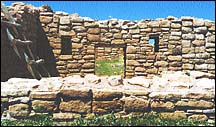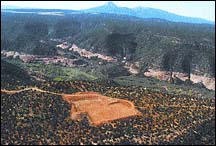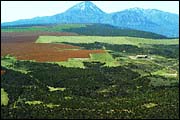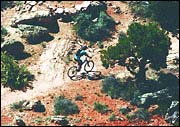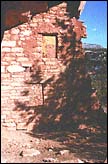|
|
||||||||||||||
|
June 10, 2000 Journal Staff Reports Clinton signs proclamation to protect desert ruins
With a stroke of his pen, President Bill Clinton placed Canyons of the Ancients National Monument on the map Friday. Clinton signed proclamations declaring four new national monuments. Besides Canyons of the Ancients, west and northwest of Cortez, he established Cascade-Siskyou National Monument in southern Oregon, the Hanford Reach National Monument in south-central Washington, and the Ironwood Forest National Monument in southern Arizona. The Canyons of the Ancients announcement contained few surprises. Tribal rights for hunting and ceremonial use of the monument lands have been preserved, as have grazing and oil-and-gas extraction rights. Overnight camping is allowed within the monument. No new water rights have been created, and the Colorado Division of Wildlife will continue to be responsible for fish and wildlife management, which could include hunting. Off-road vehicle travel has been prohibited, effective Friday, and the Wilderness Study Areas in the northern portion of the 163,852-acre monument are closed to all motorized travel. Some of the monument’s thousands of ruins, including Lowry Pueblo, will be further stabilized and developed for visitation and interpretation. Access to other ruins will not be immediately restricted, although the initial announcement left open the possibility that some restrictions might be developed. Although the proclamation contains a section specifying that private inholdings would automatically become part of the monument in the event they were acquired by the federal government, there is no provision for such an acquisition. There are 18,570 acres of private land within the monument’s boundaries. "The bottom line is that we do not have any plans to go out and acquire private lands," said Roger Alexander, public affairs specialist for the Bureau of Land Management’s regional office in Montrose. About 372 acres of National Park Service land remain unaffected, and Hovenweep National Monument will continue to be managed by the Park Service. Until a long-term management plan is announced, the BLM will direct the monument through the Anasazi Heritage Center. There were no immediate plans for a visitor center near the monument, nor for collecting any sort of entrance fee. No announcement was made Friday about officials for the new monument. The formal announcement followed months of worries by local residents, who feared they would lose access to the monument lands for traditional pursuits such as grazing and recreation, and that the county’s tax base would be severely cut if carbon-dioxide extraction were prohibited. Environmentalists had voiced concern that the protections would not be sufficient, and that increased visitation, following on the heels of increased public awareness about the monument, would harm the fragile ecosystem. The proclamation reflects guidelines developed by a local stakeholder group convened to advise the federal government about the management of what was designated in 1985 as the Anasazi Area of Critical Environmental Concern. Although Interior Secretary Bruce Babbitt had said in May that the proclamation would include a management addendum with provisions for a local advisory body to help develop a management plan for the monument, the text of that document was not available at press time. Babbitt had said that the group would include the chairman of the Ute Mountain Ute Tribe and representatives from the Montezuma and Dolores county commissions. The Federal Advisory Committee Act requires balanced representation on any federal advisory committee to reflect the diversity of users of the public land. Alexander said the committe, which will have between 10 and 15 members, would also include representatives from the oil and gas industry, livestock industry, recreationists and cultural resource experts. The announcement was made by the White House press office Friday. Earlier that day, Vice President Al Gore, the Democratic candidate in this year’s presidential election, had announced the Washington and Oregon monuments during a campaign visit to Pasco, Wash. Politicians blast new monument declaration
DENVER — U.S. Ben Nighthorse Campbell condemned President Clinton’s creation Friday of a national monument in the history-rich Four Corners area as "governing by imperial decree." The "Canyons of the Ancients National Monument" includes 164,000 acres of Bureau of Land Management land which the Interior Department says contains more than 20,000 archaeological sites. The department says it is the highest-known density of such sites in the nation. Campbell, R-Colo., was blunt in his criticism of the monument plan. "The president today continued to abuse his authority and create by executive order, not legislation, a new national monument in Colorado," he said. "The President continues to usurp Congress, abandon the role of public participation in public lands matters, and abuse his authority in a frantic war on the West that won’t end until he leaves office. He is proving once again governing by imperial decree is a lousy way to run a democracy." Campbell had introduced a bill proposing a national conservation area for the McElmo Dome area, but withdrew it after strong local opposition. U.S. Rep. Scott McInnis, R-Grand Junction, said Friday that he was disappointed with Clinton’s decision to invoke the Antiquities Act. "The President’s decision to unilaterally create a national monument in the face of widespread local opposition is clearly disappointing," McInnis said. "The unfortunate thing is that, with the NCA bill, we wrote the rules. Now, with a national monument, we’re completely at the mercy of the President." Environmentalists admit the designation will attract more attention to the site and could bring more pot hunters. "It is a two-edge sword. It will bring in more people," said Jeff Widen of the Colorado Environmental Coalition. "But the days when we could just leave things alone and they won’t be impacted are long gone. "There are too many people exploring on public land. We think this a good thing. The area out there for years cried for more attention. We’ve been advocating wilderness protection for a portion of it. Clinton is protecting our cultural heritage." Sean Conway, the press secretary for Sen. Wayne Allard, echoed McInnis’ disappointment with Clinton’s decision. "I think Sen. Allard’s reaction is that he is very disappointed that President Clinton went ahead with Secretary Babbitt’s recommendations to use the Antiquities Act to designate this area," Conway said. "His hope was that the administration would continue to work with local elected officials and citizens that are affected by this designation in coming up with a compromised plan." The Associated Press contributed to this report. Official reaction mixed: Some details worry county commissioners
The Montezuma County commission expressed a combination of satisfaction and dismay regarding the land-management parameters generally outlined Friday in a proclamation designating 164,000 acres in the county as a national monument. "Going through it there is obviously some language that is somewhat troubling, and then there is some language that is fairly positive," said Commissioner Gene Story Friday. On the positive side, Interior Secretary Bruce Babbitt, as promised, included language that protects existing grazing and oil and gas extraction within the monument, particularly important because taxes collected from CO2 extraction contribute to a substantial amount of the county’s tax base. Existing grazing leases and rights will also be respected under the new monument; however, off-road motorized or mechanized vehicle traffic will not be allowed, according to the proclamation. Concern has arisen among commissioners regarding a portion of the proclamation concerning private lands, specifically that lands "not owned by the United States shall be reserved as a part of the monument upon acquisition of title thereto by the United States." "That is certainly not the language that we had submitted," Story said. "We are very concerned about the rights of inholders and we did not want anything to be construed that the federal government could come in and put pressure on these people and acquire that land. "We had talked about language indicating ‘willing buyer and willing seller’ as far as those inholdings go, but I do not see that in here." Story also was troubled by what he interprets as possible maneuvering by the federal government to obtain water rights for the purposes of the national monument. He points to a contradictory paragraph that on one hand states that "This proclamation does not reserve water as a matter of Federal law," yet goes on to say that the "Bureau of Land Management shall work with appropriate State authorities to ensure that any water resources needed for monument purposes are available." "That is a loaded sentence that is very troubling," Story said. Commissioner Kent Lindsay also had mixed feelings about the proclamation, calling it "vague and incomplete, yet something we all have to live with." Lindsay was especially worried about preserving historic access for farmers and ranchers who reach their inholdings and grazing leases by using "roads" that may not be considered as such by federal officials responsible for implementing the resource management plan. "It does not specify what a road is under the section banning off-road motorized use," he said. "So that needs clarification."
Montezuma County’s federal land manager, Mike Preston, said that the key to the historical road access issue is a phrase that states "this monument is subject to valid existing rights." Determining those parameters is contingent largely on interpretation, but Montezuma County planners are ahead of the game in that they have recently coordinated with local ranchers to put roads not typically recognized by the BLM onto maps. "A lot of these roads had not been acknowledged but the county has contacted all of the landowners with inholdings and had them draw in accesses that were not already mapped," Preston said. "So the county had already done a considerable amount of work to establish rights of access. At the planning process, we will be there with those maps." Both Story and Lindsay were concerned that no document specifying the creation of a local advisory board was included in the proclamation, as was promised by Babbitt during a phone conversation with the commission May 31. Preston anticipated that the memorandum detailing the formation of the local advisory committee is forthcoming, and should be made available by next week. He emphasized the opportunity for local leaders and community members to address concerns that are lacking in the monument during the management plan process. "We need to wait and get the memorandum to see if it sheds any more light on these issues," he said. "It is an opportunity for Babbitt to follow up on commitments that he made with the working group and the county commission." "The key is to have a real solid advisory committee and work through the management process," Preston said. "It will take everyone’s active and constructive engagement to make it work. That is where the opportunity is to fix things and to bring everything into focus, and I expect it to be lively and active." Once the management plan is drafted, which could take up to four years, it must be then analyzed for its social, economic and ecological consequences before it becomes law, Preston said. "There were some surprises, and some gray areas, but I think that it is up to this community to see what we can make of this in a positive and balanced way," Story said, adding that the monument will affect the county on issues such as law enforcement and road maintenance. Activists, land users divided over access
It’s finally official and really no surprise that President Clinton signed a federal decree Friday designating a 164,000-acre swath of canyonlands in Montezuma County as a national monument. The vast region, now known as the Canyons of the Ancients National Monument, has been under consideration for further protection since May 1999, because of the staggering amount of Ancestral Puebloan ruins and artifacts that lie within it, a resource representing more than 1,000 years of early human history. But beyond protection of the highest-known concentration of ancient ruins in the nation, the new monument also bodes well for further protection of the rich wildlife resources and habitat in the area, according to environmental groups. The Colorado Environmental Coalition says the federal designation paves the way for establishing Wilderness Areas in order to further protect pristine canyons within the monument, including Cross, Papoose, Cahone and Squaw canyons, totalling 30,000 acres. "The monument gives us a good opportunity to create wilderness designations for lands that deserve more protection," said Jeff Widen, associate director of the coalition. "The cultural heritage is now protected, so this sets the stage for the next phase of protection, which is wilderness in those pristine canyons." The BLM supports that initiative, noting in policy documents for the monument that the Canyons of the Ancients proclamation has no effect on the Wilderness Study Areas and that Congress has many times in the past designated wilderness within existing national monuments. Widen said that the cultural protection under the monument also protects wildlife species and their habitats plus secures essential migration routes to summer and winter feeding grounds by restricting multiple use. The Canyons of the Ancients proclamation bans off-road motorized and mechanized use within the monument, including ATVs and potentially including mountain biking. Sand Canyon is an especially well-known mountain bike ride and has been written up as so in several national biking magazines. But that use is not always compatible with the natural environment, Widen said. "It is all by scale. Hiking is low impact and then it goes up from there," he said. "Biking is fairly high impact, while ATV is higher and four-wheel driving is even higher. So it is important to restrict some of these to further preserve a small portion of the 8 million acres of BLM lands in Colorado." Hiking and backcountry camping will still be allowed within the monument, according to the BLM, and there may be room for negotiation regarding mountain biking, said Roger Alexander, a BLM spokesman from the Montrose office. "Mechanized travel does refer to things like bicycles; we’re just not sure on how to read that. You could take a reading that was less literal," Alexander said.
Widen downplayed fears that creating a monument or wilderness area would further impact the region because it would attract more crowds. "In a world 50 years ago leaving things unadvertised worked, but with so many people now and so much more pressure on lands for use as well as abuse I think that protective provisions really have a net benefit even if they do bring more people in," Widen said. "This is a reality when more and more people are heading for public lands." While many recreationists undoubtedly cringe at the notion of public lands that are closed off to their favorite activity, others are willing to give up some access for the sake of preservation. "There are many areas to go off and bike and four-wheel drive, so closing off some areas to protect resources in perpetuity does not concern me at all," said Chuck McAfee. "I am a biker and an occasional four-wheeler, but I can live with this." Landowners vow to continue lobbying efforts The Southwest Colorado Landowners Association, a local group adamantly opposed to the Canyons of the Ancients National Monument, is disappointed with the proclamation but has plans to continue to lobby Congress to overturn it. "We’re really going to have to go to work now," said Chester Tozer, president of the group. The Federal Land Policy Management Act stipulates Congress can enact a concurrent resolution to revoke or modify the monument designation without presidential approval. Congress has 90 in-session days to pass the resolution. Tozer said the group will ask its members to call and write their representatives and ask them to revoke the monument. "It only takes 51 percent of Congress to stop it there," said Tozer. Although the act technically gives Congress the right to revoke the monument, U.S. Senate sources said Wednesday that the act is considered to be an ineffective way to address local concerns because most members of Congress would not support revoking a national monument. Neva Kindred, a member of the landowners coalition said she wasn’t very surprised that President Clinton signed the proclamation. "All of the public meetings were a farce," she said. "They handed you this whole pile of stuff with all of these choices (about the monument), and said ‘If you are here to oppose having a monument at all you might as well leave.’ That’s kind of like being accused of a murder, then going to trial, and being told that if you are there to defend your innocence you can forget it because all you get to do is choose whether you’re hung or electrocuted." Archaeologists stress need for management By Janelle Holden
The wealth of archaeological sites in the Canyons of the Ancients National Monument has been nationally recognized since early explorers documented their findings. Spread across the 164,000 acres are historical objects that continue to be a significant part of archeological scientific research into the lives of ancient Puebloan cultures. "There is almost nowhere else in the world where people have reconstructed the environmental change with the degree of accuracy from the past as they have here," said Mark Varien, director of research at Crow Canyon Archaeological Center. Working in close relations with the Bureau of Land Management’s area archaeologists and the Anasazi Heritage Center, the Crow Canyon Archaeological Center was formed in 1984 to initiate and conduct archaeological research in the area and around the world. The center was responsible for excavating both Sand Canyon and Castle Rock pueblos, and archaeologists have continued to monitor sites within the monument area for natural erosion and human degradation. Only 5 to 10 percent of the Sand Canyon Pueblo was excavated over a 10-year period, and after the excavation was finished the site was backfilled. Bill Lipe, a professor of anthropology at Washington State University and member of the Crow Canyon board of directors, said that most archaeologists almost never completely excavate sites because of site stabilization costs and the concern for future studies. "You can learn an enormous amount with a very small sample," Lipe said. According to Varien, the sheer quantity of sites is significant, and said that only a small fraction of the sites have even been touched. "We don’t even really know what’s out there." In addition, the arid climate has resulted in remarkable preservation. "There are things that remain on those sites that aren’t present at sites elsewhere in the world," he said. In recent years, archaeology has changed course from the study of individual sites to a more holistic approach which investigates the site within its cultural environment. Lipe said that the monument designation will help area archaeologists continue this kind of research. Southwest archaeologists have always been on the cutting edge, according to Varien. He said that many of the methods that changed archaeology into a serious science were developed in this region, and that other world archaeologists still monitor their methods. Currently, area archaeologists are concentrating on the social, political and economic structures of ancient Puebloan societies. A key tool for Southwest archaeologists is the ability to precisely date sites and measure the archeological and environmental changes from area tree ring data. Kristie Arrington, a BLM archaeologist in the San Juan field office, said that additional funding will be needed to properly manage and develop the archaeological resources. "We haven’t had enough staff to be able to manage the preservation programs and public education in the most effective and efficient way," she said. Arrington said that the BLM has consciously tried to lower the profile of the area because it hasn’t had the resources to manage a large amount of tourism and protect the sites. Vandalism has decreased in the last decade, but there has been a lot of disturbance within the past century. Varien said that he has never seen an undisturbed archaeological site in the area. Increased visitation has resulted in a problem that Varien called "loving it to death." Lipe said he is most interested in seeing the continuation of the research and educational aspects of the new monument. He says that American science and scholarship is dependent upon investigative initiated research from outside organizations. Roger Alexander, spokesman for the BLM’s Montrose regional office, said that many of the details for how the archaeological resources will be handled will be worked out within the advisory board’s management plan. Alexander does not envision that the monument will become a carbon copy of Mesa Verde National Park and begin to limit wholesale access. "We’re not the Park Service; we have a different mission. Everybody just kind of needs time to catch their breath at the moment." Lipe said that the BLM has qualified employees to manage and conduct research and education, but that there needs to be room for additional organizations to conduct research as well. "Most of these sites are pretty hard to damage unless you take a shovel to them." |
||||||||||||||
|
Copyright © 2000 the Cortez Journal.
All rights reserved. |
